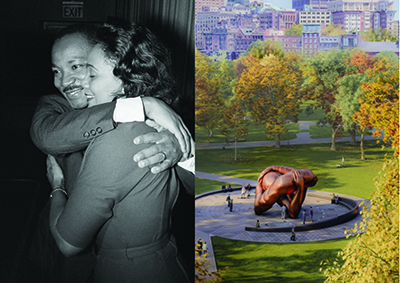By CBS NEWS
This past summer, workers at the Walla Walla Foundry, in the state of Washington, fashioned giant fingers, arms, hands, and a bracelet, to capture a shining moment in history. All the pieces are now assembled, and this Friday, one of the largest memorials dedicated to racial equality will be unveiled in America’s oldest public park, Boston Common.
It’s called “The Embrace,” and to design it, Hank Willis Thomas pored over hundreds of images of Dr. Martin Luther King, Jr., and his wife, Coretta Scott King. “There was an intimacy that I saw that wasn’t really highlighted often,” Thomas said. “Often when you do look closely at pictures, they’re holding each other’s hands.”
Dr. Martin Luther King, Jr. hugs his wife, Coretta, during a news conference following the announcement that he had been awarded the Nobel Peace Prize in 1964
One photo in particular got the sculptor’s attention: the reaction when Rev. King was awarded the Nobel Peace Prize in 1964. “I just love that image, him hugging her with such glee and such joy and such pride, and I saw the pride on her face. And I recognized that this was teamwork. And all of his weight in that picture is, like, on her.”
And so, rather than depicting whole figures, Thomas, along with architects from the MASS Design Group, decided to represent a specific moment of intimacy, depicting only their arms and hands.
“I’m kind of scared, because representing the Kings without their faces is a bold move,” Thomas said.
He also noted how important it was to depict both husband and wife. After Dr. King was shot and killed in 1968, it was Coretta who continued his work. “I was not alive when he was alive,” he said. “She was the symbol. Her grace, her presence was palpable. And I thought that was a pretty powerful metaphor for their legacy, that she put his legacy on her shoulders and carried it for almost half a century.”
“People underestimate the power of women and underestimate the power of black women and their influence on society,” said Imari Paris Jeffries, who leads Embrace Boston, the non-profit that raised $8 million to create the sculpture, and an additional $2.5 million to preserve it.
Boston is where King met Coretta Scott in the 1950s, and where he earned his Ph.D. in theology at Boston University. He preached in Boston, and in 1965, led a civil rights march from the Roxbury neighborhood to Boston Common, where “The Embrace” now stands. “It will be a symbol of Boston,” Jeffries said. “It will be a symbol of love, belonging and hope.”
Community organizer Malia Lazu visited the foundry as a supporter of the memorial. “In Boston, we just had a White supremacist march; there’s just a lot about race in Boston,” Lazu said. “And so, to see something this large and this beautiful, being done for us in Boston, was very touching.”
The process began six years ago with a national call for proposals. There were 126 submissions and five finalists. Embrace Boston did consult with the King family, but the people of Boston chose Thomas’ idea, casting their ballots at voting booths set up in post offices, libraries and city hall.
Spend time with Hank Willis Thomas and you discover he’s influenced not only by history, but by his own family. His mother, Deborah Willis, is a photographer and photo historian. A painter and sculptor, Thomas is known for canvases that come alive when you shine a light on them, revealing images inside.
He also loves metal hands that reach up, or point to the sky.
And speaking of hands, Thomas says his grandmother, Ruth Willis, who just passed away at the age of 100, was an inspiration. “She lived a masterful life. She was and is a divine spirit who has been my guide. And so, when I think about my grandmother’s hands, which were so warm and so powerful, it’s the spirit that is in this work.”
Thomas has designed a memorial that is 20 feet high, meaning visitors will be able to walk through “The Embrace” and experience that spirit themselves.
“When you’re standing inside the sculpture, you will be in the heart of their embrace,” he said. “And when you really think about what happens when two people embrace one another, their hearts [line up]. You’re inside the love of these two people. There are so many monuments to victims of war; there are very, very few monuments to love.”
